U.S. automakers spend vast sums of money to create and maintain the powerful role of cars and driving in our society. As their ads and products increasingly flaunt laws and ethics, maybe it’s time to fight back with ads that share perspective from the other side of the windshield?
“The more and more time that goes by, and the more people that are being murdered on our streets by road violence, you start losing that olive branch.”
That’s what Tom Flood creates. His short videos and other creations (see below) serve up powerful juxtapositions that make viewers stop and think about why so many Americans have decided it’s OK to drive cars as if city streets are racetracks or their personal driving playground — at great expense to everyone else.
Advertisement
Tom grew up in car-dominated suburbs and then worked in the advertising industry creating spots for carmaking clients. When he moved into urban Ontario, Canada and started biking and walking with his kids, a light bulb went off: He realized how absurd our car-dominated street culture had become.
You might have seen his work from his popular Twitter account, @TomFlood1, read his op-ed on Streetsblog about Dodge’s irresponsible marketing, or seen his “Space to Play” collab with New York City nonprofit Transportation Alternatives.
Now you can go deeper by listening to our recent conversation. I asked Tom how his work can go beyond the Twitter choir, whether he’s ready to be a full-time activist, and the challenge of balancing rage and reason as he works to spread his messages to the auto-centric masses.
See Tom’s work on his website, CreativebyRovelo.com.
For more podcast episodes, visit BikePortland.org/podcast.
Full transcript:
Jonathan Maus (00:00):
… So thanks for coming on the show, Tom.
Tom Flood (00:56):
Yeah, for sure. No problem, thanks for asking me.
Jonathan Maus (00:58):
You sort of are different kind of advocate. I’ve always been fascinated in my years in sort of looking at the bicycle advocacy industrial complex, if you will. All the different ways that people do their activism. You talk to a bike shop employee, and they’re like advocates. They’re so excited to make sure people have the right products; that’s how they are contributing, you know? And so, I mean, there’s just so many different ways people are sort of manifesting their traffic and transportation reform advocacy is how I… But yours is another different wrinkle that I haven’t really seen, and so, I wanted to share a little bit more with folks sort of about you and about the work that you’re doing, and sort of how you see it operating within what’s going on right now, and maybe moving outside of this world, anyway. So we can get into some of that stuff, but I think it’s always fun to just kind of help set the context a little bit and let folks know, where does Tom Flood come from? How did you arrive with this Twitter feed that a lot of people love to look at, that’s got these interesting videos on it? We’ll we’ll get into that later, but how did you end up here?
Tom Flood (02:12):
Yeah, I don’t know if there’s a normal path to ending up in this kind of space. For me, it definitely isn’t a normal, if there is a normal. So I grew up in a pretty normal, suburban 1980s kind of life, kid on a bike, bike around when it gets dark, come in that kind of world. And then, as soon as you’re 16, you get your license and you start driving. That was just the norm. Bikes weren’t at all a part of my transportation life, it was just for fun, running around kind of, Stranger Things type of type of idea.
And then, I moved to Toronto as soon as I could, because like many kids, you want to leave the suburbs and get to the big city. So I used to bike just to get around to bars, to gigs, whatever you do, to work, just normal living, but it was never some sort of political statement, it was just easier to get around. Didn’t have a car, didn’t want one, didn’t have money for one anyways, and it was just easier to get around the city on a bicycle.
So yeah, biked around and eventually, had a couple of kids and my light bulb moment, as they say, was the moment I took those kids out to daycare at school on the bicycle, and it was an immediate shock to my system. I don’t know, I guess I was just living in a more selfish, sheltered environment that when I was biking, I knew there were dangers when I was riding around the city, but I never really thought about it beyond, “Oh, that really sucks, oh, this guy almost hit me,” until I had my kids with me right beside me on the street. And that’s when it all kind of changed for me, when my eyes opened up somewhat to the absurdity of it all that was on our streets and something that I guess I just didn’t see. And it took that moment for me to see it.
Jonathan Maus (04:20):
And at that time, you were working in the marketing and ad ad business and sort of thing, and so tell me how you kind of ended up posting these videos, or how did you create one of these first videos?
Tom Flood (04:31):
Well, I mean, strangely enough, my formal background in careers is advertising. So I was working at a few different agencies, and I actually worked on auto accounts, again, which was the strangest thing, biking in these kind of ridiculous situations, and then going to the office and marketing those same vehicles. But yeah, so kind of fast forward to when I had my light bulb moment, I wasn’t really on social media, and I only took to it, like many people do to just kind of vent your frustrations. That’s all it was, was again, I say this a lot, but just how absurd it was, and how ridiculous the situation was, and what people outside of the car were being asked to do, just to get to something as simple as school. It was so outrageous to me when that moment happened, so it was just a place for me to vent maybe, creatively vent, but that was it, just to kind of yell about it a bit, just like everybody else.
Jonathan Maus (05:31):
And was that like four or five years, how many years ago was that?
Tom Flood (05:34):
That was maybe like six years ago. And I just did it a little bit here and there. And then, as many people that are on social media know, you start connecting with other people, and you start getting involved inside the community here, and the broader community, sort of snowballing into talking to other people, and hearing people’s shared experiences, until it got to the point it’s at now.
Jonathan Maus (05:57):
Cool. And you mentioned that vulnerability of your kids, and being with your kids as a vulnerable user biking on streets, I certainly heard that so many times, that that’s sort of the radicalizing moment for people, right? And so, I’m sure people that are hearing this are, have probably seen one of your videos, but I’m curious if you could just describe for us sort of what your videos are like, how would you describe that to someone?
Tom Flood (06:23):
That’s a great question. I mean, there’s a few, so they’re kind of different-
Jonathan Maus (06:26):
Just in general, kind of like what’s the general kind of aesthetic and sort of narrative point of these things?
Tom Flood (06:33):
You know, we as humans outside of the car are up against such a massive marketing machine from our auto overlords, as we say, that I thought it would be interesting, and again, not the first by any means at all, but interesting to try to highlight some of the absurdity in videos that are somewhat palatable for a more mainstream audience, to see some of that absurdity in maybe a more friendly way, but it’s still being subversive.
Jonathan Maus (07:08):
I take it that you’ve probably seen some traffic safety PSA’s, like from the government, maybe your local city or municipality, and maybe you’ve seen some sort of like traffic safety stuff from an advocacy groups, and care to give, like, you know, an assessment of the body of work that was existing, or that you looked at maybe before you made yours, or any input on that?
Tom Flood (07:32):
Yeah. I mean, everyone’s doing everything they can, at least from an advocacy stance. Our leadership could be doing a lot more, not everybody, but majority of them in a lot of our cities aren’t hardly doing enough. I mean, I looked at creating content that was maybe more in line with the marketing I was doing for clients, rather than some of the cut and dry things that you see from your city, for example. And again, I don’t want to generalize all cities and all people, but, you know, you-
Again, I don’t want to generalize all cities and all people, but you see the same three campaigns, it’s, “Be safe, be seen.” Then you see Halloween, “Be safe, be seen.” And at summertime, “Be safe, be seen.” It’s the same thing over, and over, and over, with always just avoiding the root of the actual problem.
Jonathan Maus (08:22):
Yeah. Yeah. One thing I always think about on these is, it’s relatively easy to reach the choir. Right? Reach the already converted, especially social media. That’s how it’s constructed, is to have a bunch of people who think and believe the same thing talking to each other. I’m just curious if you’ve thought of that in terms of getting your work out beyond the usual suspects, and reaching people outside the choir.
Tom Flood (08:48):
Yeah. That’s a great question. And again, whatever I’m doing right now was never intentional. It was never my goal to really change people’s minds or perceptions. At the beginning, at the onset of this, it was really just a place to vent. But knowing that, and things have changed, and there are campaigns I’ve been involved with now, I’ve been lucky enough to meet a lot of people that have been able to develop work with me now that’s outside of maybe this niche audience. That’s where things are hopefully going right now. I know I’ve got a few speaking engagements and workshops coming up at various universities, which is pretty amazing that that’s starting to come into fruition now.
Again, I don’t have an end goal. I’m not sure if that’s what you’re asking, but it’s been a very slow process. And again, not one that’s been planned, but a slow gradual process too. I would love to be able to have these things in the mainstream more, or this messaging that many people are doing already.
Jonathan Maus (09:53):
For instance, maybe would your goal be to have one of the big bike brands somehow…work with them to get to…Or anybody else. I was trying to think, as I was thinking about talking to you, what company would carry a message like this that’s not a government agency or something? Or how could these end up in some prime advertising space. Right? New York Times articles, or Superbowl ad. Right? Or whatever. Not that that may ever happen, but just like you said, I think that that does feel like your goal to get these in front of a bigger mainstream audience. It’s like, “How can we talk about it? How would that happen? Who would carry that message?” Would it be the trek and specialize that would somehow see the value in the advocacy impact, influence piece, that you’re I think pushing for, and then it’s a matter of who comes up with that money? Have you thought about that side? I know you’ve done work with transportation alternatives, which is great. And I’m just curious, is that something you’ve thought about?
Tom Flood (10:49):
There’s someone that’s doing a campaign in the UK the last year or so, and his name’s Adam Tranter, and he runs a bike is best campaign. I’m not sure if you’ve seen those ads.
Jonathan Maus (11:00):
Yeah. I’ve heard of that. That’s wonderful.
Yeah. Those are really good.
Tom Flood (11:02):
Yeah. He’s done an incredible job, and he’s managed to get a few manufacturers, some shops, all on board, and create this council to develop creative to push bicycling, which has been amazing. That is what he’s doing is where you want to get to, because they have a budget, and they have mainstream access.
Jonathan Maus (11:26):
Yeah. That’s another way to look at it. That makes a lot of sense. Maybe it’s an independent thing. Right? Where maybe it’s you in a consortium of other creators, but you’re not necessarily going to have to rely on someone else to carry this message. You could just create through your own funding, through your own wherewithal, you can then deliver the message to bigger and bigger audiences. Okay. Yeah. I like that. That makes me feel better. Okay. Good.
Tom Flood (11:46):
Yeah. It’s amazing what he’s done over there with those partners. Hats off to Adam, and I’ve gotten to know him a little bit, and it’s been a good to get to know that guy.
Jonathan Maus (11:55):
Yeah. The other thing that I’m really interested about, just in general with your aesthetic, and your work, and how you’re really focused on the car design, and then those two big things. At least the ones that I’ve been attracted too, this whole idea of these souped up Dodge muscle cars, which are raging, and it’s a problem nationally. We have a street racing epidemic that’s going on here. Kids are killing each other, and racing on the street, and doing all kinds of doughnuts, and all kinds of stuff.
Then there’s also the big truck thing, which is related, but separate. There’s actually some advocacy that’s been happening on this stuff, but I’m curious, from your perspective…I saw a talk you did where you talked about, you wanted to make sure that the stories you’re telling, and that advocates are telling is relatable, and not too mean to the other side or something like that.
I’m curious, if you could just share your thoughts on that balance, because your stuff is clearly saying, “Hey, these cars are really not great, and I don’t like them.” It reminds me of a friend of mine posted something on Twitter, about a huge truck and how they should not even be allowed on the street, and there was a massive, massive front grill on this big pickup. And he got so harangued, somebody found it, there was some truck club or something, and they were going after him.
Tom Flood (13:13):
I think I remember that.
Jonathan Maus (13:14):
I know you’re aware of this idea that, “You have to build a bridge to the other side, we’ve got to make this more relatable and mainstream,” but then it also has to be direct. Is that a conflict for you? How do you deal with that?
Tom Flood (13:24):
Yeah. No, that’s a great question. And the more and more time that goes by, and the more people that are being murdered on our streets by road violence, you start losing that olive branch, it starts becoming, “No I think we have to go the other way.”
For me personally, anything I share as just myself, I don’t have to look at it through that lens because it’s just me and how I feel. But if developing things for other groups or organizations, you have to be conscious of that. And again, sadly it comes down to…We’ve been reverent to the car and the driver for so long, even the smallest ask is monumental. Yeah, I’m tired of the kid gloves. I’m tired of having to coddle drivers to ensure that nothing is disrupted in their free flowing God given right to get around town, but it’s exhausting.
And I know your question is about balance. I think it really depends on the situation, and who your intended audience is. There has to be some middle ground at some point. Yeah. It’s a conflict to develop that creative messaging when you feel strongly that it needs to be such leaps and bounds of where it is already.
Jonathan Maus (14:58):
Yeah. And hearing you say that makes me think that the future for Tom Floods Creative, or whatever, this campaign, let’s say the future of that is really going to depend on whether you can maintain this independence or not. Because as you know, and I’ve experienced for years, if you were to do work for government agencies, or for even bike corporations. And I’m not sure if you know, you probably know, but a lot of the big bike brands are in love with car companies.
I was really close to pointing that out. In an op-ed at one point, I don’t think I ever did. I may have beaten around the bush, but there was one point where even people for bikes, which is the biggest player in US National Advocacy, they have this huge sponsorship with Volkswagen, a massive one.
It was almost their title sponsor. And it’s like, wait Volkswagen lied to the EPA about their mission. They’re a terrible, terrible company. Anyway, that’s this underlying thing. Your response to that question about balance is like, “Well, personally I hope that you’re able to stay independent so we can get some of that emotion maintaining…
… Independent so we can get some of that emotion keeping into the creative. Because I think it’s important, I agree.
Tom Flood (16:08):
I think so too. And I think it’s important to be subversive and try to highlight that absurdity, but in a way that people can just understand. It is so ridiculous, kind of this mainstream narrative of, you want your kid to bike to school, and automatically you’re anti-car. You’re just labeled. Pick your poison. You want your senior mother to walk to the store, well, anti-car. It’s unbelievable what’s happened to the mainstream narrative of who people on bikes are, who the people are that want spaces that are accessible and safe for everyone. It’s incredible, the propaganda machine that’s gone over the last 100, 70, and then hyper drive in the last 30 years.
Jonathan Maus (17:04):
Yeah, I mean, that term propaganda machine, you used the word ‘overlords’. I mean, do you think there’s this malevolent force like ‘Big Auto’? You’ve sort of been in the industry, I’m assuming you maybe sat in on some pitch meetings with some auto industry people. How much credence do you think there is to the idea that there is this ‘Big Auto’ and are they this malevolent force or is it … What do you think about that?
Tom Flood (17:29):
No. I’ll speak to my experience, but it wasn’t as malicious as … It’d be a better story if I could tell you it was. It seemed malicious. But you know what? That’s what makes it so insidious, is that it’s been so gradual that we’ve barely even noticed what’s happened until all of a sudden you’re like … Again, I always think it’s so funny and so indicative of our culture, when people find out I drive. It’s not like I’m proud that I drive, but it’s just like, “Yeah, I have a car, I use it.” Like, “Oh, you do?” Like, “Well, what do you think? Just because I want my kids not to be run over, I don’t have a car?” Jesus, what’s happened? It’s been so well done. And again, I don’t even think it’s been done intentionally, it’s been such a slow process of taking space away from people outside the car that all of a sudden we’re left with what? Not much. And if you ask for a little bit, again, you’re just immediately labeled as some outsider.
Jonathan Maus (18:26):
Yeah, put yourself in a Dodge marketing person’s shoes. How do you think they would respond to your videos and these criticisms?
Tom Flood (18:38):
Well, I mean Dodge and their whole lineup is … I can’t speak to any inside meetings there, but I mean they’re marketing road violence. If you’ve seen any one of their ads, it’s absolutely astonishing.
Jonathan Maus (18:53):
I’m curious how you think they would respond? Would they laugh at it and just embrace it and say, “Sorry, you social justice warrior. Too bad. This is the cars people want,” or would they take it into consideration and think, “Gosh, I really-”
What do you think? Would they deny it? How do you think … I’m curious.
Tom Flood (19:10):
Would they deny what they’re doing?
Jonathan Maus (19:13):
Yeah, would they say, “Oh, you’re completely a crackpot, what are you talking about? No one agrees with you. You’re on the fringe.” I mean, have you ever thought about that?
Tom Flood (19:20):
No, not really because I don’t think they care at all. I don’t think there’s any thought from them. There’s nothing I’ve made creatively that’s changed any of what they’ve done. What they’ve created looks like satire. It looks like … I wrote a piece for Streets Blog a little while ago, but it’s like elementary school playground bravado, that’s the best way to put it. The way they describe their cars, it’s like 10 year olds talking in the park. And it’s real, and they love it, they eat it up, and the people that love their cars, they also enjoy that.
Jonathan Maus (19:59):
It’s so hard to watch it. I mean, once you’ve sort of clicked over to this other side that I think you and I are both on, because I’m absolutely the same way with these ads. There’s such this dissonance where I’m kind of laughing at them because I feel like these are massive matchbox cars and they’re just little kids playing. And so it’s super hilarious how their sad, mental health, toxic masculinity problems are being exposed. Yet while I laugh at that it’s got such a serious consequence. I mean, right? Speeding through the neighborhood one time and a kid can die or somebody can die. I mean, that’s what’s so unsettling about this. And I think that’s kind of what you’ve hit on with your pieces.
Tom Flood (20:45):
Yeah, I mean Dodge is the great example. Just the way they promote their vehicles are exactly the opposite of how we’re supposed to operate our vehicles. It’s just the exact opposite. And it’s all fine and well because they put in a two point font that says, “Closed course, do not attempt at home.” But …
Jonathan Maus (21:04):
Yeah, I mean, play politician for a sec, or policy maker, like you mentioned, yes they do have some warning labels, sort of, on these ads, which are absurd and no one really notices them. What do you think would be a sensible response to this? What if a car company did engage you and said, “Okay Tom … ” Maybe it’s Volvo. They seem to be the only ones with any kind of conscience, and they said, “Okay Tom, let’s see, we’re going to pay you a consulting fee and we’re going to bring you in. What kind of stuff can we do to sort of satisfy your concerns?” What would it be? Would it be a huge label like on cigarette cartons or something like that? Have you ever thought about that? What would that kind of regulation look like in your mind?
Tom Flood (21:47):
Interesting. I mean, I guess right now I’d be the wrong person to want to make a car ad, because again, we’ve been selling it like it’s a party for 100 years, where it’s exactly not a party. But if I was asked, “What can we do right now?” Yeah, absolutely there should be massive warning labels on these things. That’s a good question.
Jonathan Maus (22:10):
Do you think you can make a car ad that would make driving look like fun, but then the driving wouldn’t be so deadly? Is that possible? It’s possible, right?
Tom Flood (22:21):
Yeah. Well, it is possible. Part of the problem, and again, it’s been so gradual that we’ve been telling everybody it’s a super good time and it’s going to be the best, where as soon as something’s fun then you’re maybe not paying attention to what you should be doing, which is operating this thing. If I had my druthers as they say, we would completely overhaul how vehicles are marketed. But it’s too late because it’s already in us and in our culture now to expect unobstructed movement and every whim and desire we have as drivers to be satisfied in our cars. And if it doesn’t go that way, then we’re really, really angry about it. And it’s just ridiculous.
Jonathan Maus (23:08):
Yeah, and it’s so massive, right? I mean, the auto industry is usually the top one or two spenders and buyers of advertising as an industry category, like 13, 14 billion dollars a year. So it’s such a juggernaut of content essentially and reach, it’s almost as if it’s going to have to, for anything to sort of stem that tide it’s going to have to be cultural perceptions shifting on a large scale, right? Where these companies all of a sudden look like they’re [inaudible 00:23:39], or look like they’re out of step with what consumers want if they’re marketing danger I guess. In that regard, that feels a little bit hopeful because if that’s what people like you and other advocates, and Bike Portland to some degree, where we’re publishing stuff in this space. That’s the kind of stuff we can play some role in, is shifting perceptions over time and getting more people to care about stuff.
Tom Flood (24:02):
Yeah, no, and it’s a long game for sure, but-
Jonathan Maus (24:03):
… more people to care about stuff.
Tom Flood (24:03):
Yeah, no and it’s a long game for sure, but truly hats off to yourself and the organization for the work you do. I always want to ensure we tip our hats to our local organizations that really do the heavy lifting day in and day out. These are the people that work tirelessly. When I can bail out on a council meeting or mouth off or something, they can’t because they’re in a position where they are the authoritative voice and they’re trying to make the change right there and then. So, I always want to make sure I tip my hat to the people that do this day in and day out. So, thanks. Thank you.
Jonathan Maus (24:43):
Yeah. Yeah. Yeah, you’re welcome. And on that note, one of my favorite groups in the country is Transportation Alternatives. Tell me a little bit about that project.
Tom Flood (24:53):
Yeah, I connected with the Executive Director, Danny Harris. We have a campaign, New York City, 25 by 25, and they wanted to highlight some of the positive change that could happen on our streets and put those pieces together. I’m not sure if you saw them, but yeah they’re up there somewhere.
Jonathan Maus (25:10):
Yeah, they look great. I wonder if you have any advice on what can transportation reform advocates, bike advocates, walking, what can people that see your stuff and follow you, what can they do to amplify this thing and just increase the reach? Is there a DIY grassroots way to build this reach that we can’t afford through buying ad space?
Tom Flood (25:35):
That’s an interesting thought and you’ve kind of mentioned that a couple times now. I’m starting to think about what that next step could be to do that. Why not? And I again, I think about Adam in the UK and how he’s managed to actually do it, which is incredible. And I don’t have an answer for you right now, but it is something that I think about it more and more now, maybe that is the next step in trying to organize something, whatever that may be.
Jonathan Maus (26:06):
Sorry if this is too personal, we could edit it out, but are you at a place in your life where you can work on this more? I mean do you work 60 hours a week for a boss and you’re doing this on the side and you’re at your wits end? Or are you at a place where let’s say you could develop a stronger independent camp and get it going, like the one in the UK? Is that something you’re in a position to do?
Tom Flood (26:27):
Yeah. I mean I still work marketing as a job as well as.
Jonathan Maus (26:36):
So, did I Tom. So, okay. You can jump, man. Come on, let’s go do this thing.
Tom Flood (26:42):
[inaudible 00:26:42] as more and more continue to present themselves, this side of my life is starting to take over a lot more time than it ever had before. So, to answer your question, yeah there is bandwidth and there’s bandwidth because I kind of believe in the end goal of trying to change things even though I started out with zero interest and it was just a place to yell and scream, even though I do that sometimes still.
Jonathan Maus (27:12):
That’s great. So, it sounds like end goal could be, yeah could be something like sort of a broader campaign. One thing I want to ask is there anything you can say about response to your stuff that has been negative? Have people found you from, I don’t know, some Dodge truck Facebook group, and went after you? I’m curious, has there been any negative like opposition to your stuff yet? I haven’t seen it personally.
Tom Flood (27:37):
Well there’s always online kind of trolls and such. I don’t really know if there’s been anything extremely negative. I lost my Twitter account for a while, went down. But I’m back now, which is good.
Jonathan Maus (27:53):
I was going to ask you about that. Was that a copyright thing or what?
Tom Flood (27:57):
Yeah, but I’ve been trying to figure out what set it off. So, I’ve got my account back and I’m still kind of waiting for responses and I’ve had some people reach out who work at Twitter, from our Twitter family to offer assistance. So, that’s been really nice. But yeah, no, I haven’t had any calls from Dodge.
Jonathan Maus (28:19):
Darn it because that would really solidify the malevolent overlord, big auto I think we’re all hoping is out there, so we have a foil to go up against. Bicycle Lobby versus Big Auto, come on. Someone just start a Big Auto Twitter handle, I guess there’s some that are trying to do that, but that would be so funny. Is there anything else that you want folks to about Tom Flood or what you’re trying to do?
Tom Flood (28:44):
I’m pretty grateful for all the people been able to meet in this space and that’s something that I was completely unexpected when I first started logging into social media. I did not expect to meet so many people and so many good people and so many smart people that I’m able to learn from now. It’s been amazing to be honest because as much of a cesspool the space can be, I got to tell you when my account went down about a month ago and then I kind of woke up with, oh, my accounts’ gone. It was really strange to lose those connections to people that you’ve kind of been to talking with daily. It’s like another family and it’s been, yeah. So, I think the relationships it’s been amazing and encouraging and seeing everyone’s work kind of throughout north America and the world is pretty inspiring and that’s yeah, it’s been great.
Jonathan Maus (29:36):
That’s so cool. So, with any luck maybe those relationships and that sort of second online family can be the thing that can launch something, a big campaign in the future, no pressure or anything. I’m just saying that would be interesting. Well I appreciate you coming on Tom and sharing this with us. Thank you.
Tom Flood (29:54):
Yeah. Thank you very much.
— Jonathan Maus: (503) 706-8804, @jonathan_maus on Twitter and jonathan@bikeportland.org
— Get our headlines delivered to your inbox.
— Support this independent community media outlet with a one-time contribution or monthly subscription.




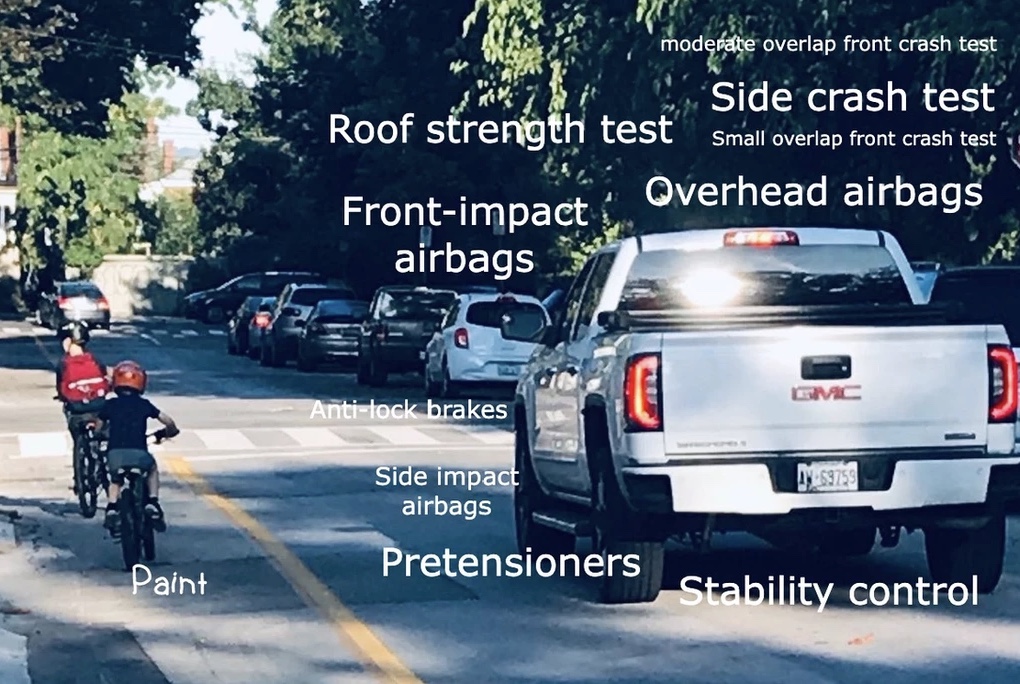
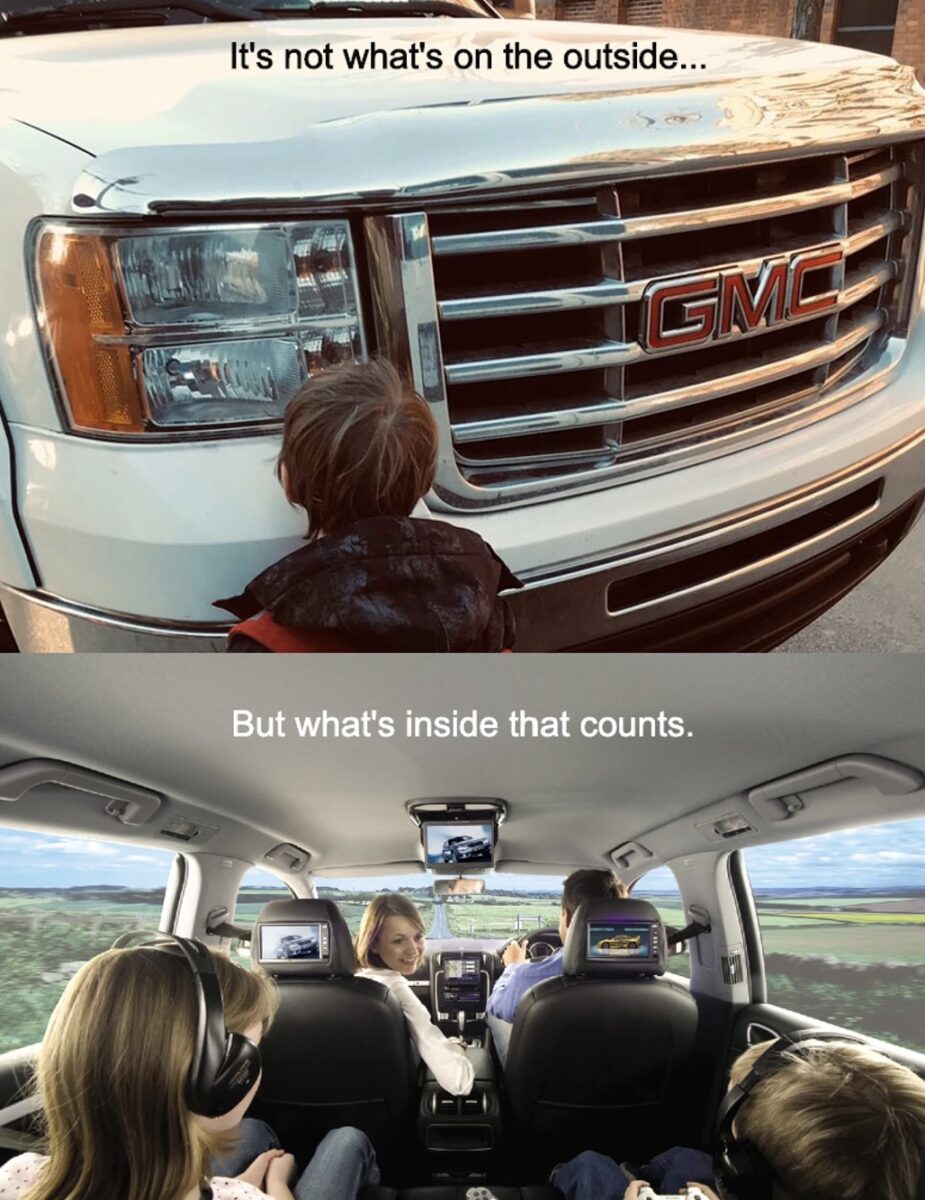
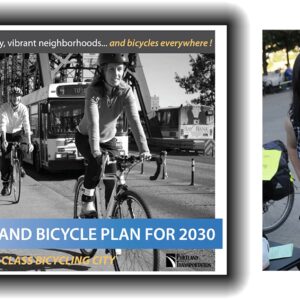
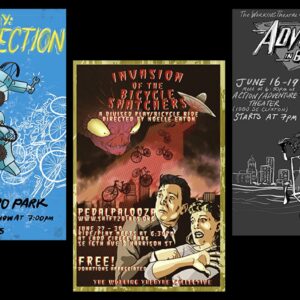

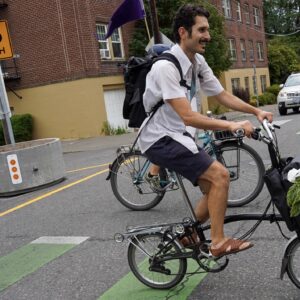
Thanks for reading.
BikePortland has served this community with independent community journalism since 2005. We rely on subscriptions from readers like you to survive. Your financial support is vital in keeping this valuable resource alive and well.
Please subscribe today to strengthen and expand our work.
Great discussion on an important topic. After viewing Tom’s videos, I think something like
the “Advertising Works” piece (https://www.creativebyrovelo.com/?pgid=ka2k578m4-c3375d36-865c-4250-9ded-cd5d624429a2) has the potential to be very impactful. Maybe something with a split screen, like the Nike “You can’t stop us” ad. Where the car advertisements are on the left and real-life is on the right. Maybe the split would completely show the right side at some times, where the results would be shown, like a car sliding into a tree, or the aftermath of a crash.